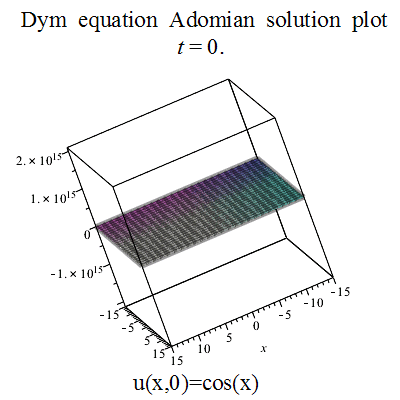|
Decomposition Method (other)
Decomposition method is a generic term for solutions of various problems and design of algorithms in which the basic idea is to decompose the problem into subproblems. The term may specifically refer to one of the following. *Decomposition method (constraint satisfaction) in constraint satisfaction *Decomposition method in multidisciplinary design optimization *Adomian decomposition method, a non-numerical method for solving nonlinear differential equations *Domain decomposition methods In mathematics, numerical analysis, and numerical partial differential equations, domain decomposition methods solve a boundary value problem by splitting it into smaller boundary value problems on subdomains and iterating to coordinate the soluti ... in mathematics, numerical analysis, and numerical partial differential equations * Cholesky decomposition method * Decomposition method in queueing network analysis {{disambig ... [...More Info...] [...Related Items...] OR: [Wikipedia] [Google] [Baidu] |
Decomposition Method (constraint Satisfaction)
In constraint satisfaction, a decomposition method translates a constraint satisfaction problem into another constraint satisfaction problem that is binary and acyclic. Decomposition methods work by grouping variables into sets, and solving a subproblem for each set. These translations are done because solving binary acyclic problems is a tractable problem. Each structural restriction defined a measure of complexity of solving the problem after conversion; this measure is called ''width''. Fixing a maximal allowed width is a way for identifying a subclass of constraint satisfaction problems. Solving problems in this class is polynomial for most decompositions; if this holds for a decomposition, the class of fixed-width problems form a tractable subclass of constraint satisfaction problems. Overview Decomposition methods translate a problem into a new one that is easier to solve. The new problem only contains binary constraints; their scopes form a directed acyclic graph. The va ... [...More Info...] [...Related Items...] OR: [Wikipedia] [Google] [Baidu] |
Multidisciplinary Design Optimization
Multi-disciplinary design optimization (MDO) is a field of engineering that uses optimization methods to solve design problems incorporating a number of disciplines. It is also known as multidisciplinary system design optimization (MSDO), and Multidisciplinary Design Analysis and Optimization (MDAO). MDO allows designers to incorporate all relevant disciplines simultaneously. The optimum of the simultaneous problem is superior to the design found by optimizing each discipline sequentially, since it can exploit the interactions between the disciplines. However, including all disciplines simultaneously significantly increases the complexity of the problem. These techniques have been used in a number of fields, including automobile design, naval architecture, electronics, architecture, computers, and electricity distribution. However, the largest number of applications have been in the field of aerospace engineering, such as aircraft and spacecraft design. For example, the prop ... [...More Info...] [...Related Items...] OR: [Wikipedia] [Google] [Baidu] |
Adomian Decomposition Method
The Adomian decomposition method (ADM) is a semi-analytical method for solving ordinary and partial nonlinear differential equations. The method was developed from the 1970s to the 1990s by George Adomian, chair of the Center for Applied Mathematics at the University of Georgia. It is further extensible to stochastic systems by using the Ito integral. The aim of this method is towards a unified theory for the solution of partial differential equations (PDE); an aim which has been superseded by the more general theory of the homotopy analysis method. The crucial aspect of the method is employment of the "Adomian polynomials" which allow for solution convergence of the nonlinear portion of the equation, without simply linearizing the system. These polynomials mathematically generalize to a Maclaurin series about an arbitrary external parameter; which gives the solution method more flexibility than direct Taylor series expansion. Ordinary differential equations Adomian m ... [...More Info...] [...Related Items...] OR: [Wikipedia] [Google] [Baidu] |
Domain Decomposition Methods
In mathematics, numerical analysis, and numerical partial differential equations, domain decomposition methods solve a boundary value problem by splitting it into smaller boundary value problems on subdomains and iterating to coordinate the solution between adjacent subdomains. A coarse problem with one or few unknowns per subdomain is used to further coordinate the solution between the subdomains globally. The problems on the subdomains are independent, which makes domain decomposition methods suitable for parallel computing. Domain decomposition methods are typically used as preconditioners for Krylov space iterative methods, such as the conjugate gradient method, GMRES, and LOBPCG. In overlapping domain decomposition methods, the subdomains overlap by more than the interface. Overlapping domain decomposition methods include the Schwarz alternating method and the additive Schwarz method. Many domain decomposition methods can be written and analyzed as a special case of the abstr ... [...More Info...] [...Related Items...] OR: [Wikipedia] [Google] [Baidu] |
Cholesky Decomposition Method
In linear algebra, the Cholesky decomposition or Cholesky factorization (pronounced ) is a decomposition of a Hermitian, positive-definite matrix into the product of a lower triangular matrix and its conjugate transpose, which is useful for efficient numerical solutions, e.g., Monte Carlo simulations. It was discovered by André-Louis Cholesky for real matrices, and posthumously published in 1924. When it is applicable, the Cholesky decomposition is roughly twice as efficient as the LU decomposition for solving systems of linear equations. Statement The Cholesky decomposition of a Hermitian positive-definite matrix A, is a decomposition of the form : \mathbf = \mathbf^*, where L is a lower triangular matrix with real and positive diagonal entries, and L* denotes the conjugate transpose of L. Every Hermitian positive-definite matrix (and thus also every real-valued symmetric positive-definite matrix) has a unique Cholesky decomposition. The converse holds trivially: if ... [...More Info...] [...Related Items...] OR: [Wikipedia] [Google] [Baidu] |


